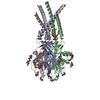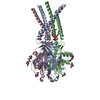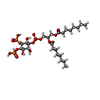+ データを開く
データを開く
- 基本情報
基本情報
| 登録情報 | データベース: PDB / ID: 8eq4 | ||||||||||||
|---|---|---|---|---|---|---|---|---|---|---|---|---|---|
| タイトル | Human PAC in nanodisc at pH 4.0 with PI(4,5)P2 diC8 | ||||||||||||
 要素 要素 | Proton-activated chloride channel | ||||||||||||
 キーワード キーワード | MEMBRANE PROTEIN / PAC / TMEM206 / ASOR / PAORAC / ion channels / chloride channel | ||||||||||||
| 機能・相同性 | pH-gated chloride channel activity / TMEM206 protein / TMEM206 protein family / chloride transport / chloride channel complex / cell surface / plasma membrane / Chem-PIO / Proton-activated chloride channel 機能・相同性情報 機能・相同性情報 | ||||||||||||
| 生物種 |  Homo sapiens (ヒト) Homo sapiens (ヒト) | ||||||||||||
| 手法 | 電子顕微鏡法 / 単粒子再構成法 / クライオ電子顕微鏡法 / 解像度: 2.71 Å | ||||||||||||
 データ登録者 データ登録者 | Ruan, Z. / Lu, W. | ||||||||||||
| 資金援助 |  米国, 3件 米国, 3件
| ||||||||||||
 引用 引用 |  ジャーナル: Elife / 年: 2023 ジャーナル: Elife / 年: 2023タイトル: Inhibition of the proton-activated chloride channel PAC by PIP. 著者: Ljubica Mihaljević / Zheng Ruan / James Osei-Owusu / Wei Lü / Zhaozhu Qiu /  要旨: Proton-activated chloride (PAC) channel is a ubiquitously expressed pH-sensing ion channel, encoded by (). PAC regulates endosomal acidification and macropinosome shrinkage by releasing chloride ...Proton-activated chloride (PAC) channel is a ubiquitously expressed pH-sensing ion channel, encoded by (). PAC regulates endosomal acidification and macropinosome shrinkage by releasing chloride from the organelle lumens. It is also found at the cell surface, where it is activated under pathological conditions related to acidosis and contributes to acid-induced cell death. However, the pharmacology of the PAC channel is poorly understood. Here, we report that phosphatidylinositol (4,5)-bisphosphate (PIP) potently inhibits PAC channel activity. We solved the cryo-electron microscopy structure of PAC with PIP at pH 4.0 and identified its putative binding site, which, surprisingly, locates on the extracellular side of the transmembrane domain (TMD). While the overall conformation resembles the previously resolved PAC structure in the desensitized state, the TMD undergoes remodeling upon PIP-binding. Structural and electrophysiological analyses suggest that PIP inhibits the PAC channel by stabilizing the channel in a desensitized-like conformation. Our findings identify PIP as a new pharmacological tool for the PAC channel and lay the foundation for future drug discovery targeting this channel. | ||||||||||||
| 履歴 |
|
- 構造の表示
構造の表示
| 構造ビューア | 分子:  Molmil Molmil Jmol/JSmol Jmol/JSmol |
|---|
- ダウンロードとリンク
ダウンロードとリンク
- ダウンロード
ダウンロード
| PDBx/mmCIF形式 |  8eq4.cif.gz 8eq4.cif.gz | 184.3 KB | 表示 |  PDBx/mmCIF形式 PDBx/mmCIF形式 |
|---|---|---|---|---|
| PDB形式 |  pdb8eq4.ent.gz pdb8eq4.ent.gz | 表示 |  PDB形式 PDB形式 | |
| PDBx/mmJSON形式 |  8eq4.json.gz 8eq4.json.gz | ツリー表示 |  PDBx/mmJSON形式 PDBx/mmJSON形式 | |
| その他 |  その他のダウンロード その他のダウンロード |
-検証レポート
| 文書・要旨 |  8eq4_validation.pdf.gz 8eq4_validation.pdf.gz | 1.9 MB | 表示 |  wwPDB検証レポート wwPDB検証レポート |
|---|---|---|---|---|
| 文書・詳細版 |  8eq4_full_validation.pdf.gz 8eq4_full_validation.pdf.gz | 1.9 MB | 表示 | |
| XML形式データ |  8eq4_validation.xml.gz 8eq4_validation.xml.gz | 38.8 KB | 表示 | |
| CIF形式データ |  8eq4_validation.cif.gz 8eq4_validation.cif.gz | 50.3 KB | 表示 | |
| アーカイブディレクトリ |  https://data.pdbj.org/pub/pdb/validation_reports/eq/8eq4 https://data.pdbj.org/pub/pdb/validation_reports/eq/8eq4 ftp://data.pdbj.org/pub/pdb/validation_reports/eq/8eq4 ftp://data.pdbj.org/pub/pdb/validation_reports/eq/8eq4 | HTTPS FTP |
-関連構造データ
| 関連構造データ |  28535MC  8fblC M: このデータのモデリングに利用したマップデータ C: 同じ文献を引用 ( |
|---|---|
| 類似構造データ | 類似検索 - 機能・相同性  F&H 検索 F&H 検索 |
- リンク
リンク
- 集合体
集合体
| 登録構造単位 | 
|
|---|---|
| 1 |
|
- 要素
要素
| #1: タンパク質 | 分子量: 40092.047 Da / 分子数: 3 / 由来タイプ: 組換発現 / 由来: (組換発現)  Homo sapiens (ヒト) / 遺伝子: PACC1, C1orf75, TMEM206 / 発現宿主: Homo sapiens (ヒト) / 遺伝子: PACC1, C1orf75, TMEM206 / 発現宿主:  Homo sapiens (ヒト) / 参照: UniProt: Q9H813 Homo sapiens (ヒト) / 参照: UniProt: Q9H813#2: 糖 | ChemComp-NAG / #3: 化合物 | 研究の焦点であるリガンドがあるか | Y | Has protein modification | Y | |
|---|
-実験情報
-実験
| 実験 | 手法: 電子顕微鏡法 |
|---|---|
| EM実験 | 試料の集合状態: PARTICLE / 3次元再構成法: 単粒子再構成法 |
- 試料調製
試料調製
| 構成要素 | 名称: Proton activated chloride channel at pH 4.0 with 0.5mM PIP2 タイプ: COMPLEX / Entity ID: #1 / 由来: RECOMBINANT |
|---|---|
| 由来(天然) | 生物種:  Homo sapiens (ヒト) Homo sapiens (ヒト) |
| 由来(組換発現) | 生物種:  Homo sapiens (ヒト) Homo sapiens (ヒト) |
| 緩衝液 | pH: 4 |
| 試料 | 濃度: 5 mg/ml / 包埋: NO / シャドウイング: NO / 染色: NO / 凍結: YES |
| 急速凍結 | 装置: FEI VITROBOT MARK IV / 凍結剤: ETHANE / 湿度: 100 % / 凍結前の試料温度: 291 K |
- 電子顕微鏡撮影
電子顕微鏡撮影
| 実験機器 |  モデル: Titan Krios / 画像提供: FEI Company |
|---|---|
| 顕微鏡 | モデル: FEI TITAN KRIOS |
| 電子銃 | 電子線源:  FIELD EMISSION GUN / 加速電圧: 300 kV / 照射モード: FLOOD BEAM FIELD EMISSION GUN / 加速電圧: 300 kV / 照射モード: FLOOD BEAM |
| 電子レンズ | モード: BRIGHT FIELD / 最大 デフォーカス(公称値): 24000 nm / 最小 デフォーカス(公称値): 6000 nm / Cs: 2.7 mm / C2レンズ絞り径: 70 µm |
| 撮影 | 電子線照射量: 50 e/Å2 フィルム・検出器のモデル: GATAN K3 BIOQUANTUM (6k x 4k) |
- 解析
解析
| ソフトウェア | 名称: PHENIX / バージョン: 1.20.1_4487: / 分類: 精密化 | ||||||||||||||||||||||||
|---|---|---|---|---|---|---|---|---|---|---|---|---|---|---|---|---|---|---|---|---|---|---|---|---|---|
| CTF補正 | タイプ: NONE | ||||||||||||||||||||||||
| 3次元再構成 | 解像度: 2.71 Å / 解像度の算出法: FSC 0.143 CUT-OFF / 粒子像の数: 84149 / 対称性のタイプ: POINT | ||||||||||||||||||||||||
| 拘束条件 |
|
 ムービー
ムービー コントローラー
コントローラー




 PDBj
PDBj



